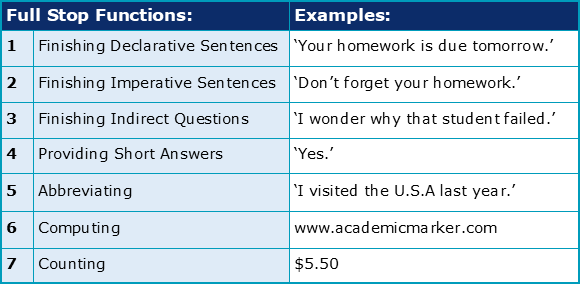Which punctuation mark is a full stop (or period)?

This is the first of three chapters about Full Stops. To complete this reader, read each chapter carefully and then unlock and complete our materials to check your understanding.
– Introduce the full stop as a type of punctuation mark
– Outline in brief in the seven functions of full stops
– Provide a brief history of the full stop
Chapter 1
Learning how to punctuate an English sentence correctly can be a challenging task for both native and non-native speakers of the language. Not only are there a large number of rules surrounding how and when to include apostrophes, brackets, commas and colons, for example, but these rules and uses tend vary from country to country and culture to culture. For informal communication in English – such as through text messages or emails to friends, it’s not so important to be correct with your punctuation every time. However, for academics conducting research or for anyone that wishes to publish their writing, it’s critical that every punctuation mark is comprehensively understood and consistently used.
Academic Marker’s short three-chapter reader focuses specifically on the correct usage of full stops. This first chapter aims to introduce the basics of full stops, explaining the history, purpose and many uses of this punctuation mark. Chapters 2 and 3 then take a closer look at the seven functions of full stops as well as the six most important rules to follow if a student wishes to remain grammatical. Once these three chapters have been carefully read and understood, you may then wish to both bookmark this reader for future reference and unlock our related beginner, intermediate and advanced worksheets to check your understanding.
What is a full stop?
Also known as a period in American English, the full stop is one of the simplest and most commonly used punctuation marks in the English language, with almost half of all punctuation marks ever written being of this type. Not only is this mark incredibly frequent (and therefore useful), but at least five other elements of punctuation have been created directly from the full stop:






From left to right, the previous images show how the full stop is an element of the colon, semicolon, ellipsis, question mark and exclamation mark.
Although the full stop may have as many as seven important functions, its primary grammatical use is to clarify to the reader where one sentence ends and another begins. With this in mind, and focusing on academic contexts, its likely that many students of academic English do not use this punctuation mark enough in their writing, assuming that longer sentences are more appropriate and academic – when in fact it’s clarity and concision that’s most preferable.
What’s the history of the full stop?
Introduced by the Greek grammarian Aristophanes of Byzantium alongside the comma and colon, the full stop was originally created to assist the reader with better interpreting and reading out loud a text. While the early marks that Aristophanes created were a series of dots placed at different heights to inform the reader of how deep and long a breath should be when reading, today’s descendent punctuation marks are instead informed more by grammatical rules than simply how and when to pause – with the full stop being one of the most important.
What are the seven functions of full stops?
Now that you understand where the full stop came from and how it’s most generally used, if you wish to include this punctuation mark most effectively in your own writing then it’s important to confidently know and employ its many functions. Though only introduced and exemplified here, the following seven functions of full stops are explored in much more detail in Chapter 2:

Having now discussed the very basics of full stops, to learn more about the functions and rules of this punctuation mark, continue on to Chapters 2 and 3.
Downloadables
Once you’ve completed all three chapters about full stops, you might also wish to download our beginner, intermediate and advanced worksheets to test your progress or print for your students. These professional PDF worksheets can be easily accessed for only a few Academic Marks.
Collect Academic Marks
-
100 Marks for joining
-
25 Marks for daily e-learning
-
100-200 for feedback/testimonials
-
100-500 for referring your colleages/friends